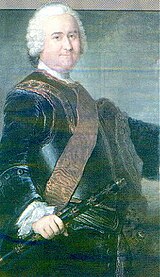The attempt to create a Kingdom of Finland in 1742 is a little known chapter in the history of Finland. Following the Russian occupation in the Russo-Swedish War (1741–1743) and vague promises of making the country independent, Finns elected the then Duke Peter of Holstein-Gottorp (who later became heir to the throne of Russia and tsar as Peter III) as the King of Finland. However, the political situation had outgrown the idea of Finnish independence and it quickly evaporated.

James Keith was a Scottish mercenary in the service of Russia and Prussia.
Background
Duke Peter of Holstein-Gottorp was the closest living relative (great-nephew) of the childless King Charles XII of Sweden. Even though he was just a 14-year-old German who had never even been to Sweden, he was very popular among the peasantry, in Finland especially for the fact that he was also the nephew of Empress Elizabeth of Russia and could thus ensure a more enduring peace.
When the Russian counter-offensive started in March 1742, Chancellor Bestuzhev probably toyed with the idea of making a buffer state in between Sweden and Russia. Tsarina Elizabeth presented Finns—then still a part of the Kingdom of Sweden—with a declaration where she promised to make Finland independent unless they resisted her troops.
By July 1742, Russia had occupied all of Finland, meeting almost no resistance at all due to ineffective Swedish military command and forces, and that month a group of Finnish peasants pleaded the Russians to make the duke the King of Sweden.
General James Keith, a Scottish mercenary responsible for the occupying Russian forces in the south, called for the estates of southwestern Finland—roughly today's Finland Proper and Satakunta—to meet at lantdag in Turku (Åbo) on October 8, 1742. Each city and hundred was to send one from nobility and two from clergy, bourgeoisie and peasants to discuss matters important for the "cities and the whole country".
Known representatives that showed up in the city were e.g. freiherrs Henrik Rehbinder and Johan Gripenberg, vicars from Loimaa, Halikko, Pöytyä and Maaria and mayors of Rauma and Pori. Names of peasants have not survived, but they were probably best represented. On the official agenda presented by Keith were mostly daily proceedings, but Russians also assured to nominate only local officials and improve usage of the Finnish language in the domestic administration. Encouraged by Russians' earlier promises of independence, friendly occupation and their own apparent willingness to seize the moment, Finns presented the general with the decision to ask Duke Peter of Holstein-Gottorp to be the King of Finland. It is not known how the lantdag reached that decision as no official records of the meeting have survived, but from Russians' internal correspondence it seems evident that it was on the Finns' initiative. Preparations to form a delegation to present the Empress with the request started.
At the same time, the riksdag had gathered in Stockholm, trying to find a way out of the military and political situation generated by the Hats' hasty and ill-advised war. As King Frederick I was without an heir apparent, the Swedish estates decided to use the future crown in negotiations, also selecting the same Duke as the next King of Sweden.

Events were however developing at a fast pace. Russian troops had taken over Finland with much ease, and Elizabeth decided to make Duke Peter her own heir to the Imperial throne, as she was without an heir apparent herself. The Swedish parliament was unaware of this, and when their envoy arrived in Saint Petersburg, it was too late. The underage Peter's succession rights to Sweden were renounced on his behalf.
New negotiations were thus opened, and Elizabeth agreed to restore the greater part of Finland if her cousin, Adolph Frederick of Holstein, was elected successor to the Swedish crown, thus concluding the war by the Treaty of Åbo on May 7, 1743.
Long unaware of the procedures elsewhere, the Finnish delegation was still only preparing for its trip to Saint Petersburg, when the word of Elizabeth's new mood reached them. Russians effectively stopped the process there, and the lantdag representatives left for their homes. Most probably the duke never got to know about his election to the ephemeral throne of Finland.
Aftermath
Disappointment in the results of the Turku lantdag generated some plans to make a revolt against the Russian occupation. No concrete actions came out of those plans.
In general, the events of the Turku lantdag in 1742 had no consequences after the Russian occupation ended the following year. Elizabeth's new candidate was elected as the next King of Sweden and some Finnish territory was ceded to Russia. However, the events clearly resemble what happened 70 years later in the Finnish War which ended up with the Finnish estates gathering in the Diet of Porvoo and swearing their oaths of loyalty to the Russian Emperor Alexander I as the Grand Duke of Finland. Interestingly, Alexander was the grandson of the said Duke Peter.
Yeah Alright, Cheers!
In Turku Town
24-8-2010
Simo Tuomola

Ei kommentteja:
Lähetä kommentti